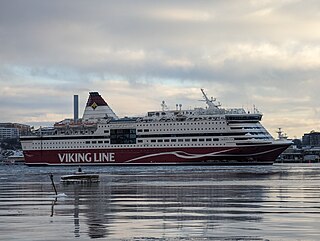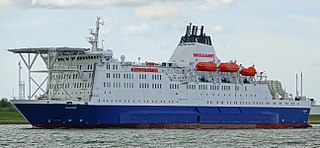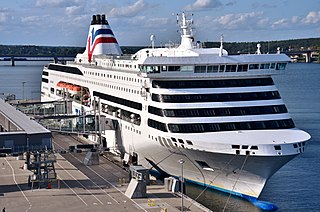Silja Line is a Finnish shipping company and cruiseferry brand owned and operated by the Estonian shipping company AS Tallink Grupp, for car, cargo and passenger traffic between Finland and Sweden.

Viking Line Abp is a Finnish shipping company that operates a fleet of ferries and cruiseferries between Finland, the Åland Islands, Sweden and Estonia. Viking Line shares are quoted on the Helsinki Stock Exchange. Viking Line is operated from Åland.

MS Estonia was a cruiseferry built in 1980 for the Finnish shipping company Rederi Ab Sally by Meyer Werft, in Papenburg, West Germany. She was employed on ferry routes between Finland and Sweden by various companies until 1993, when she was sold to Nordström & Thulin for use on Estline's Tallinn–Stockholm route. The ship's sinking on 28 September 1994, in the Baltic Sea between Sweden, Finland and Estonia, was one of the worst peacetime maritime disasters of the 20th century, claiming 852 lives.

MS Silja Serenade is a cruiseferry owned by the Estonian shipping company Tallink Grupp, operating under their Silja Line brand on a route connecting Helsinki to Stockholm via Mariehamn. She was built in 1990 by Masa-Yards at Turku New Shipyard, Finland. From 26 June 2020, to 13 September 2020, the ship's route was Helsinki–Riga, which got replaced by the cruiseferry MS Baltic Queen.

MS Silja Symphony is a cruiseferry owned by the Estonian shipping company Tallink Group, operated under their Silja Line brand on a route connecting Helsinki, Finland to Stockholm, Sweden via Mariehamn. She was built in 1991 at Masa-Yards Turku New Shipyard, Finland.

Mega Andrea is a cruiseferry owned and operated by Corsica Ferries Sardinia Ferries. She was formerly owned and operated by the Estonia-based Tallink as the MS Silja Festival, and used on their route connecting Riga, Latvia to Stockholm, Sweden. She was built in 1986 by Wärtsilä Helsinki Shipyard, Finland, for Effoa as MS Wellamo for use on Silja Line traffic. She was rebuilt in 1992 at Lloyds Werft, Bremerhaven, Germany as Silja Festival. In 2008 the ship was transferred from the Silja Line fleet to that of Tallink, but she retained her Silja-prefixed name. After being replaced by MS Isabelle on the Stockholm-Riga route in May 2013 she was chartered as an accommodation ship to Kitimat, British Columbia. She was then sold in early 2015 to Corsica Ferries.

Celestyal Crystal is a cruise ship, operated between 2007 and 2023 by the Cyprus-based Louis Group's Louis Cruise Lines and Celestyal Cruises. The ship was originally built as the cruiseferry Viking Saga in the 1980 at Wärtsilä Perno Shipyard and Turku Shipyard, Turku, Finland for Rederi Ab Sally. In 1986 she was renamed Sally Albatross, and rebuilt into a cruise ship the following year. The ship was destroyed by a fire in 1990, and completely rebuilt at Finnyards, Rauma, Finland. She was re-delivered in 1992, still named Sally Albatross. After partially sinking 1994 she was rebuilt at Industrie Navali Meccaniche Affini, La Spezia, Italy, re-entering service as Leeward for Norwegian Cruise Line. Subsequently she sailed as SuperStar Taurus for Star Cruises, Silja Opera for Silja Line. After being temporarily renamed Opera she was in service with Louis Group as Louis Cristal and later Celestyal Crystal.
Rederi AB Slite was a Swedish shipping company, founded in 1947. The company was one of the three founding companies of Viking Line. Rederi AB Slite went bankrupt in 1993.
Tallink is an Estonian shipping company operating Baltic Sea cruiseferries and ropax ships from Estonia to Finland, Estonia to Sweden and Finland to Sweden. It is the largest passenger and cargo shipping company in the Baltic Sea region. It owns Silja Line and a part of SeaRail. Tallink Hotels runs four hotels in Tallinn. It is also the co-owner of a taxi company Tallink Takso.

MS Viking Cinderella is a cruiseferry built in 1989 at Wärtsilä Marine Perno Shipyard in Turku, Finland, as MS Cinderella for SF Line, one of the owners of the Viking Line consortium. She's currently used on the Helsinki to Stockholm route.

The MS Anemos is a cruiseferry, built in 1980 by Wärtsilä Turku shipyard, Finland for SF Line, one of the owners of the Viking Line consortium. She served as Rosella on Viking Line's Kapellskär–Mariehamn route before being sold to Aegean Sea Lines as Anemos in January 2023.

The MS Bluefort was an accommodation vessel owned by the Canadian-based company Bridgemans Services Group LP. She was built in 1979 as a car/passenger ferry by Meyer Werft, Papenburg, Germany as Diana II av Slite for Rederi AB Slite for use in Viking Line's traffic. She has also sailed under the names Diana II, Vironia, Mare Balticum, Meloodia and ARV 1.

The MS Rigel III is a cruiseferry owned by the Greek-based company Ventouris Ferries. She was built in 1979 as MS Turella by Wärtsilä Turku shipyard, Finland for SF Line for use in Viking Line traffic. In 1988 she was sold to Stena Line, becoming MS Stena Nordica. In 1996, she was transferred to Lion Ferry and was renamed MS Lion King. In 1998, she was sold to Tallink and renamed MS Fantaasia. As Fantaasia she also sailed under charter to Algérie Ferries, Comanav and Kystlink during the years 2005–2008. Following the end of her charter to Kystlink in 2008 the latter company bought her, renaming her MS Kongshavn. After Kystlink was declared bankrupt in late 2008 the ship was laid up until sold to the Croatia-based ferry operator Blue Line International, and operated on their service between Split and Ancona as MS Regina della Pace. In 2017 the ship was sold to the Greek-based company Ventouris Ferries and is currently operating on the route Bari-Durres.

MS Vana Tallinn was a cruiseferry owned by the Estonian ferry company Tallink and operated on the line between Kapellskär and Paldiski. She was built in 1974 by Aalborg Skibsværft AS, Aalborg, Denmark for DFDS as MS Dana Regina, and has sailed under the names MS Nord Estonia and MS Thor Heyerdahl.

MS Star Pisces was a cruise ship owned by Star Cruises and did short cruises from Hong Kong. She was originally built as the cruiseferry MS Kalypso in 1990 at Masa-Yards Turku New Shipyard, Finland for Rederi AB Slite for use in Viking Line traffic. The ship was designed by Per Dockson. Star Pisces had a sister ship, Pearl Seaways.

MS Galaxy 1 is a cruise ferry built in 2006 by Aker Finnyards, Rauma, Finland and was at the time the largest ship delivered to ferry operator Tallink. Between 2006–2008 she held the distinction of being the largest ship ever to be registered in Estonia; a title later held by her replacement the sister ship MS Baltic Princess.

MS Romantika is a cruiseferry owned by the Estonian ferry company Tallink. The ship's latest use was on a charter to Holland Norway Lines for the route Kristiansand to Emden, until the ferry company's bankruptcy in 2023.

The Baltic Sea is crossed by several cruiseferry lines. Some important shipping companies are Viking Line, Silja Line, Tallink, St. Peter Line and Eckerö Line.

MS Baltic Princess is a cruiseliner owned by the Estonia-based ferry operator Tallink and operated under their Silja Line brand. She was built by Aker Finnyards Helsinki New Shipyard in Helsinki, Finland in 2008. The ship began service on the cruise route between Helsinki, Finland to Tallinn, Estonia on 17 August 2008. From 1 February 2013 the ship began service on the Turku–Mariehamn–Stockholm route.

MS Baltic Queen is a cruiseferry owned by the Estonia-based ferry operator Tallink. The ship was built by the STX Europe shipyard in Rauma, Finland.





















